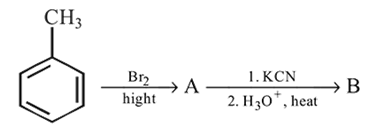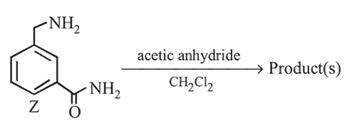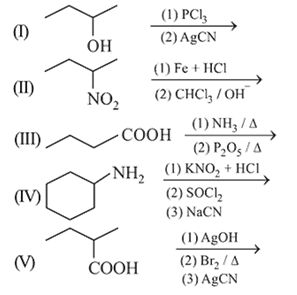Test: Preparation and Properties of derivatives of Cyanides & Isocyanides - JEE MCQ
Test Description
15 Questions MCQ Test - Test: Preparation and Properties of derivatives of Cyanides & Isocyanides
Test: Preparation and Properties of derivatives of Cyanides & Isocyanides for JEE 2025 is part of JEE preparation. The Test: Preparation and Properties of derivatives of Cyanides & Isocyanides questions and answers have been prepared
according to the JEE exam syllabus.The Test: Preparation and Properties of derivatives of Cyanides & Isocyanides MCQs are made for JEE 2025 Exam.
Find important definitions, questions, notes, meanings, examples, exercises, MCQs and online tests for Test: Preparation and Properties of derivatives of Cyanides & Isocyanides below.
Solutions of Test: Preparation and Properties of derivatives of Cyanides & Isocyanides questions in English are available as part of our course for JEE & Test: Preparation and Properties of derivatives of Cyanides & Isocyanides solutions in
Hindi for JEE course.
Download more important topics, notes, lectures and mock test series for JEE Exam by signing up for free. Attempt Test: Preparation and Properties of derivatives of Cyanides & Isocyanides | 15 questions in 20 minutes | Mock test for JEE preparation | Free important questions MCQ to study for JEE Exam | Download free PDF with solutions
Test: Preparation and Properties of derivatives of Cyanides & Isocyanides - Question 1
What is the final product (B) of this sequence?

Detailed Solution for Test: Preparation and Properties of derivatives of Cyanides & Isocyanides - Question 1
Test: Preparation and Properties of derivatives of Cyanides & Isocyanides - Question 2
Aniline reacts with phosgene and  to form
to form
 to form
to form
Detailed Solution for Test: Preparation and Properties of derivatives of Cyanides & Isocyanides - Question 2
Test: Preparation and Properties of derivatives of Cyanides & Isocyanides - Question 3
In the reaction  the product obtained is
the product obtained is
Detailed Solution for Test: Preparation and Properties of derivatives of Cyanides & Isocyanides - Question 3
Test: Preparation and Properties of derivatives of Cyanides & Isocyanides - Question 4
Acetaldoxime reacts with  to give
to give
 to give
to give
Detailed Solution for Test: Preparation and Properties of derivatives of Cyanides & Isocyanides - Question 4
Test: Preparation and Properties of derivatives of Cyanides & Isocyanides - Question 5
The molecular formula of the final product of the following synthetic scheme is

Detailed Solution for Test: Preparation and Properties of derivatives of Cyanides & Isocyanides - Question 5
Test: Preparation and Properties of derivatives of Cyanides & Isocyanides - Question 6
Which of the following reactions does not yield an amine
Detailed Solution for Test: Preparation and Properties of derivatives of Cyanides & Isocyanides - Question 6
Test: Preparation and Properties of derivatives of Cyanides & Isocyanides - Question 7
In the mechanism of Hoffmann reaction, which intermediate rearranges to alkyl isocyanate?
Detailed Solution for Test: Preparation and Properties of derivatives of Cyanides & Isocyanides - Question 7
Test: Preparation and Properties of derivatives of Cyanides & Isocyanides - Question 8
The yield of a acetanilide in the reaction (100% conversion) of 2 moles of aniline with 1 mole of acetic anhydride is
Detailed Solution for Test: Preparation and Properties of derivatives of Cyanides & Isocyanides - Question 8
Test: Preparation and Properties of derivatives of Cyanides & Isocyanides - Question 9
In the reaction shown below, the major product(s) formed is/are

Detailed Solution for Test: Preparation and Properties of derivatives of Cyanides & Isocyanides - Question 9
Test: Preparation and Properties of derivatives of Cyanides & Isocyanides - Question 10
Which of the following statements regarding amides is not correct?
Detailed Solution for Test: Preparation and Properties of derivatives of Cyanides & Isocyanides - Question 10
Test: Preparation and Properties of derivatives of Cyanides & Isocyanides - Question 11
Which named reaction is used to convert amides into amines
Detailed Solution for Test: Preparation and Properties of derivatives of Cyanides & Isocyanides - Question 11
Test: Preparation and Properties of derivatives of Cyanides & Isocyanides - Question 12
Acetamide is treated with the following reagents separately. Which one of these would yield methyl amine?
Detailed Solution for Test: Preparation and Properties of derivatives of Cyanides & Isocyanides - Question 12
Test: Preparation and Properties of derivatives of Cyanides & Isocyanides - Question 13
Total number of reactions in which isocyanides are formed


Detailed Solution for Test: Preparation and Properties of derivatives of Cyanides & Isocyanides - Question 13
Test: Preparation and Properties of derivatives of Cyanides & Isocyanides - Question 14
The major product obtained in the following reaction is :
Detailed Solution for Test: Preparation and Properties of derivatives of Cyanides & Isocyanides - Question 14
Test: Preparation and Properties of derivatives of Cyanides & Isocyanides - Question 15
An organic compound (A) on reduction gives compound (B). (B) on treatment with  and alcoholic
and alcoholic  gives (C). (C) on catalytic reduction gives N-methylaniline. The compound A is
gives (C). (C) on catalytic reduction gives N-methylaniline. The compound A is
 and alcoholic
and alcoholic  gives (C). (C) on catalytic reduction gives N-methylaniline. The compound A is
gives (C). (C) on catalytic reduction gives N-methylaniline. The compound A is
Detailed Solution for Test: Preparation and Properties of derivatives of Cyanides & Isocyanides - Question 15
Information about Test: Preparation and Properties of derivatives of Cyanides & Isocyanides Page
In this test you can find the Exam questions for Test: Preparation and Properties of derivatives of Cyanides & Isocyanides solved & explained in the simplest way possible.
Besides giving Questions and answers for Test: Preparation and Properties of derivatives of Cyanides & Isocyanides, EduRev gives you an ample number of Online tests for practice
Download as PDF








 displaces I and form benzyl cyanide.
displaces I and form benzyl cyanide.





 group is acetylated by acetic anhydride in methylene chloride (solvent).
group is acetylated by acetic anhydride in methylene chloride (solvent).
 group does not undergo acetylation because here lone pair of electrons is delocalised.
group does not undergo acetylation because here lone pair of electrons is delocalised.

 gives methylamine it is known as Hoffmann Bromamide reaction.
gives methylamine it is known as Hoffmann Bromamide reaction.

















